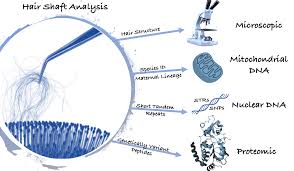
The Science Behind DNA Testing Using Hair Samples
DNA testing has revolutionized the field of genetics and forensic science, providing valuable insights into our ancestry, health risks, and even solving criminal cases. While DNA is commonly extracted from blood or saliva samples, advancements in technology have made it possible to conduct DNA tests using hair samples.
How It Works
Each hair follicle contains cells with DNA that can be extracted for testing. The process typically involves plucking a few strands of hair from the root and sending them to a laboratory for analysis. The DNA extracted from the hair can then be compared to other samples for various purposes.
Benefits of Hair DNA Testing
Using hair samples for DNA testing offers several advantages. Hair is easy to collect and store, making it a convenient option for individuals who may find it difficult to provide blood or saliva samples. Additionally, hair can retain DNA for longer periods, allowing for testing even when other sample types are not available.
Applications of Hair DNA Testing
Hair DNA testing can be used in a variety of contexts, including paternity testing, ancestry analysis, and forensic investigations. In paternity cases, hair samples can provide conclusive evidence of biological relationships between individuals. Ancestry tests using hair can reveal information about one’s genetic heritage and origins.
Considerations
While hair DNA testing offers many benefits, it is essential to ensure that proper procedures are followed to obtain accurate results. Collecting the hair sample correctly and preserving it in suitable conditions are critical steps in the process. Additionally, choosing a reputable laboratory with experience in analyzing hair DNA is crucial for reliable outcomes.
Conclusion
The use of hair samples for DNA testing has expanded the possibilities of genetic analysis and identification. Whether used for personal curiosity or legal purposes, the ability to extract valuable genetic information from a simple strand of hair underscores the power of modern science in unlocking the secrets hidden within our own biology.
Understanding DNA Testing with Hair: Accuracy, Feasibility, and Comparisons
- How accurate is a DNA test with hair?
- Is DNA test possible from hair?
- Is hair or saliva better for DNA test?
- Why is hair not used for DNA testing?
How accurate is a DNA test with hair?
The accuracy of a DNA test using hair samples depends on several factors, including the quality of the sample collected and the testing methods used by the laboratory. While DNA can be extracted from hair follicles, it is essential to ensure that the sample contains an adequate amount of genetic material for reliable results. Proper handling and processing of the hair sample are crucial to minimize contamination and ensure accurate analysis. Choosing a reputable laboratory with expertise in hair DNA testing can increase the likelihood of obtaining precise and trustworthy results. Overall, when conducted following best practices, DNA tests using hair samples can provide accurate genetic information for various purposes, such as paternity testing or ancestry analysis.
Is DNA test possible from hair?
Yes, DNA testing from hair is indeed possible. Each hair follicle contains cells with DNA that can be extracted for analysis. By plucking a few strands of hair from the root and sending them to a laboratory, it is feasible to extract and analyze the DNA present in the hair sample. This method has become increasingly common and reliable, offering an alternative to traditional blood or saliva samples for conducting DNA tests. With advancements in technology, DNA testing using hair samples has proven to be a valuable and effective means of obtaining genetic information for various purposes, including paternity testing, ancestry analysis, and forensic investigations.
Is hair or saliva better for DNA test?
When considering whether hair or saliva is better for a DNA test, it ultimately depends on the specific circumstances and requirements of the test. Saliva samples are commonly preferred for DNA testing due to their ease of collection and high DNA yield. Saliva collection is non-invasive and simple, making it a convenient option for many individuals. On the other hand, hair samples can also be used for DNA testing and offer advantages such as longer-term storage of DNA and suitability in cases where collecting saliva may not be feasible. The choice between hair and saliva samples should be based on factors such as the type of test being conducted, sample collection preferences, and the expertise of the testing laboratory in handling different sample types.
Why is hair not used for DNA testing?
Hair is not commonly used for DNA testing due to several reasons. While hair follicles contain DNA, the quality and quantity of DNA extracted from hair samples can vary significantly. The presence of external contaminants, such as hair products or environmental factors, can affect the accuracy of DNA analysis. Additionally, the root of the hair follicle, where the highest concentration of DNA is found, may not always be present in shed hairs. As a result, blood or saliva samples are often preferred for DNA testing as they provide more reliable and consistent results. Despite these challenges, advancements in technology continue to improve the viability of using hair samples for genetic analysis in certain contexts.
